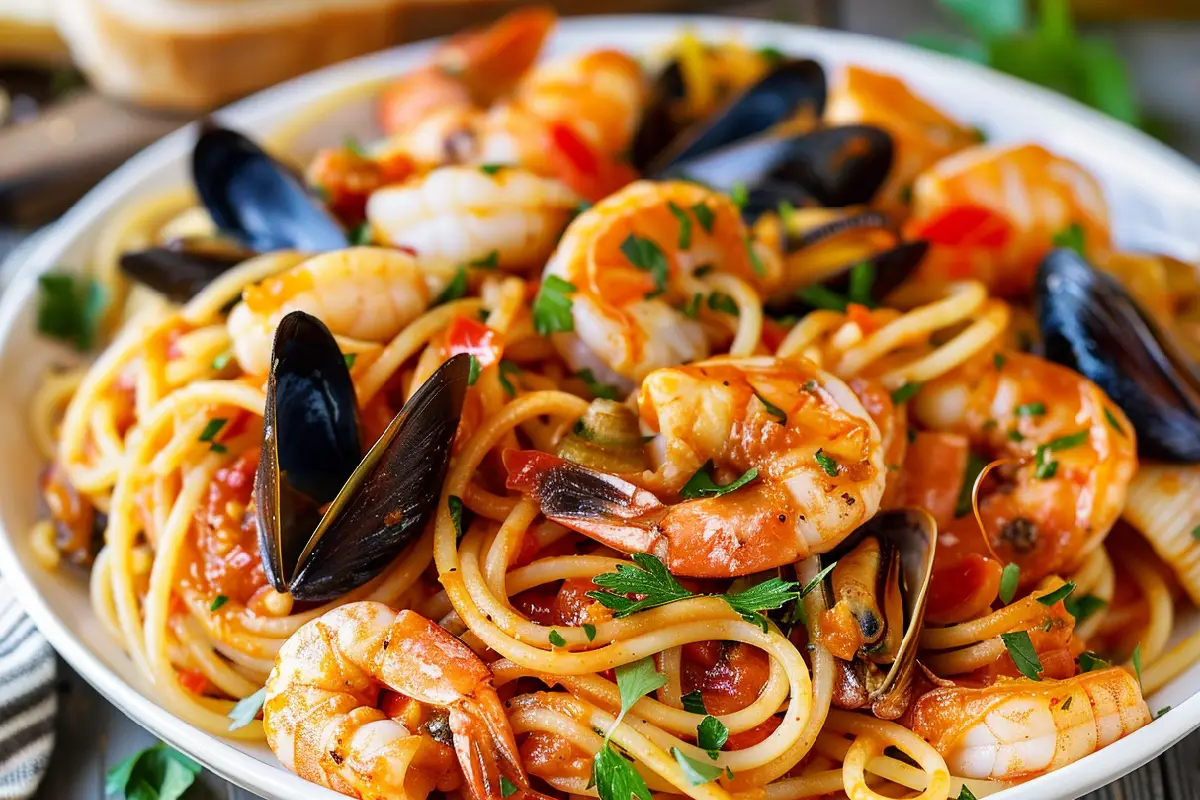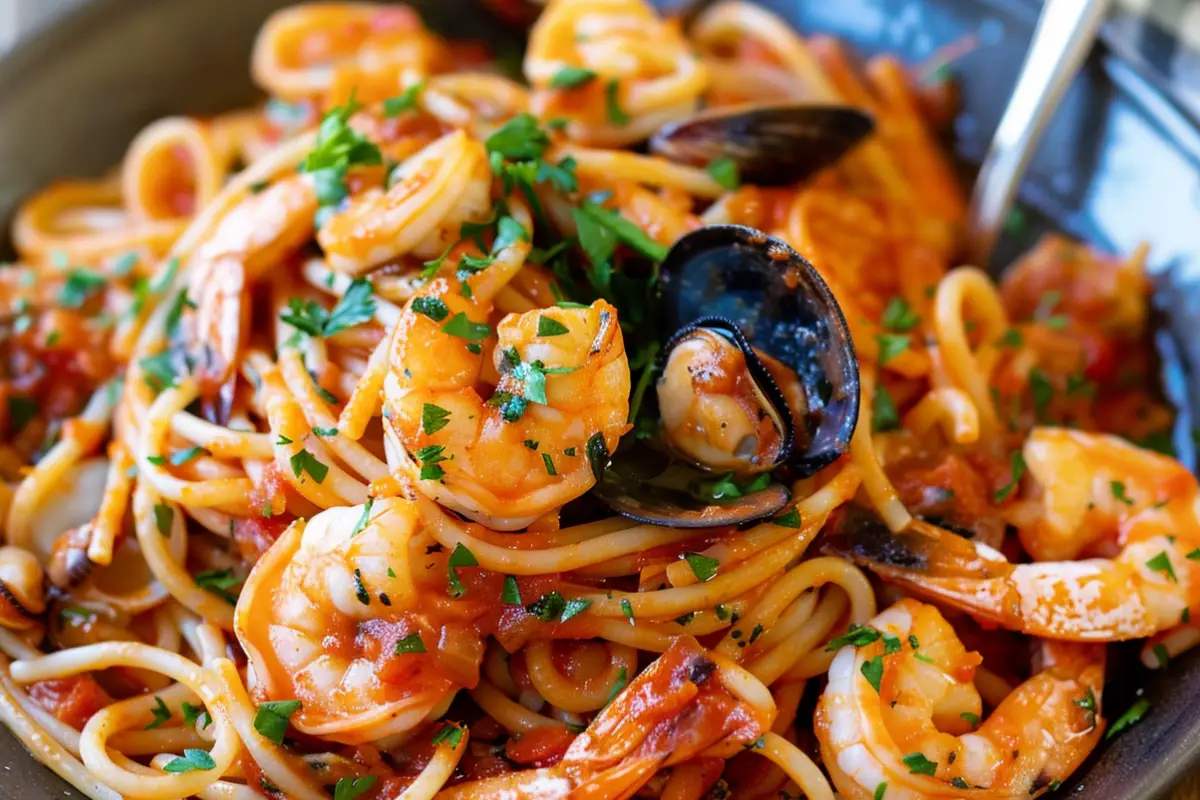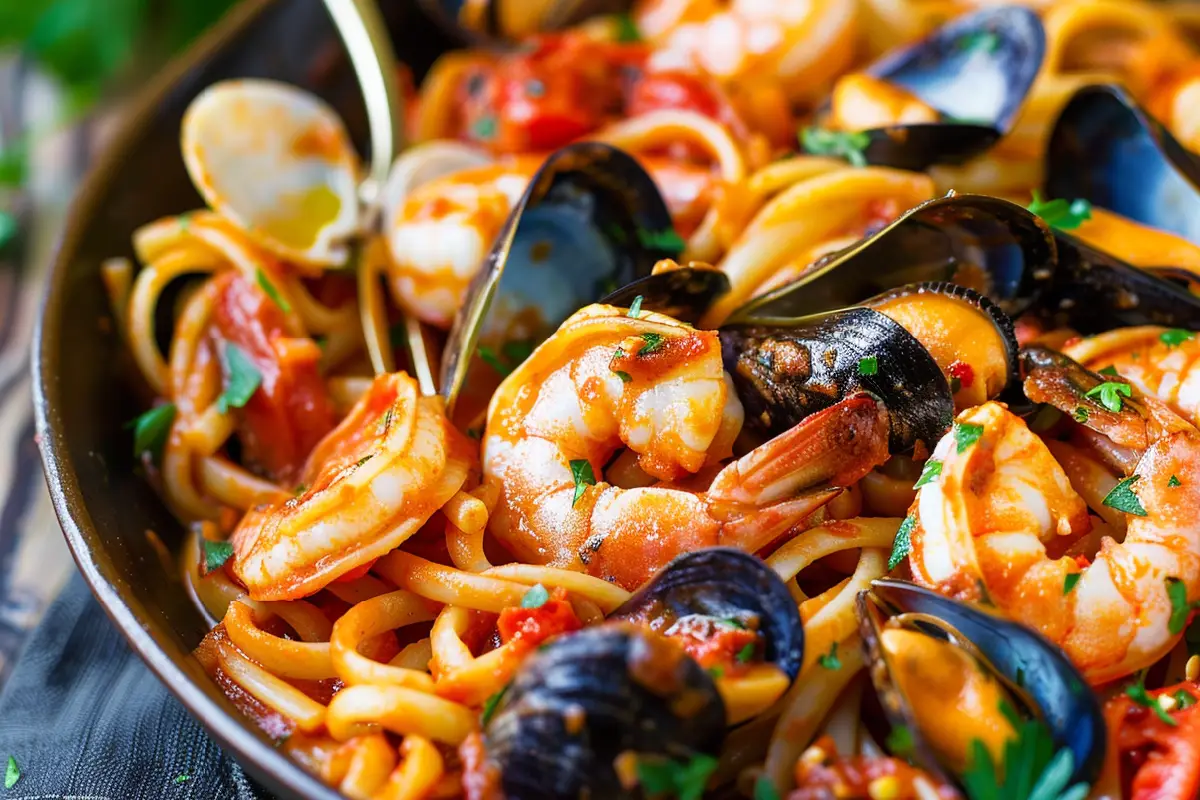Seafood pasta dishes are a delightful combination of rich, creamy sauces and the fresh, delicate flavors of seafood. However, achieving the perfect consistency for your sauce can sometimes be a challenge. A sauce that’s too thin can make your dish feel incomplete, as it won’t cling to the pasta properly. Mastering how to thicken seafood pasta sauce is essential for elevating your cooking and making every bite flavorful and satisfying.
Whether your goal is to create a creamy Alfredo, a rich tomato-based sauce, or a light and delicate seafood sauce, there are various methods to achieve the ideal thickness. In this article, we’ll explore several effective techniques, practical tips, and common challenges, so you can confidently make perfectly thickened sauces every time. For more insights on creating perfect sauces, you can also check out this detailed seafood boil sauce recipe that includes tips on balancing flavor and texture.
Common Challenges with Seafood Pasta Sauce
The most common issue with seafood pasta sauces is achieving the right texture. A sauce that’s too thin not only looks unappetizing but also fails to coat the pasta effectively, resulting in a less satisfying meal. The challenge often lies in balancing the liquid components, particularly when cooking with seafood, which can release extra moisture into the sauce. Understanding the various ways to thicken your sauce can help you overcome these issues and make your dishes more delicious and visually appealing.
Additionally, it’s important to match the thickening method to the type of sauce you’re making. For example, a rich, dairy-based sauce might benefit from cream or cheese, while a lighter, broth-based sauce might need a starch or reduction method. You can also explore specific seafood dishes like Argentine shrimp with linguine to see how these thickening techniques can be applied in different recipes.
Methods to Thicken Seafood Pasta Sauce

1. Use a Starch-Based Thickener
Starch-based thickeners are a versatile and effective way to thicken sauces. They work quickly and can be adjusted to achieve your desired consistency without drastically altering the flavor.
- Cornstarch Slurry: A cornstarch slurry is one of the most straightforward methods. To make it, mix 1 tablespoon of cornstarch with 2 tablespoons of cold water. Gradually whisk this mixture into your simmering sauce, stirring constantly to prevent lumps. The sauce will begin to thicken almost immediately. This method is especially good for clear or light sauces where you want to maintain a delicate texture.
- Flour Roux: A roux is a classic French technique made by cooking equal parts butter and flour until it turns golden. This mixture is then whisked into the sauce, creating a rich, velvety texture. Roux is ideal for thicker, cream-based sauces and adds a buttery depth to the flavor.
- Arrowroot Powder: Arrowroot is a gluten-free alternative to cornstarch that thickens sauces without making them cloudy. It’s particularly effective in clear or glossy sauces, providing a smooth, cohesive texture.
2. Reduce the Sauce
Reducing the sauce is a simple yet powerful technique that involves simmering the sauce to evaporate excess liquid, thereby concentrating its flavors and thickening its consistency. This method works well for nearly all types of sauces, as it doesn’t require additional ingredients that could alter the flavor profile.
- How to Reduce: To reduce your sauce, bring it to a gentle simmer and allow it to cook down, stirring occasionally. Be patient, as this method can take some time, especially for larger quantities of sauce. You’ll know it’s ready when the sauce has reached your desired thickness and clings to the back of a spoon.
- Best Uses: Reduction works particularly well for wine-based sauces, broths, and tomato sauces. It not only thickens but also enhances the depth of flavor, making it ideal for more robust seafood pasta dishes.
3. Use Cream or Cheese
Adding cream or cheese is an excellent way to thicken your seafood pasta sauce while adding a layer of rich, luxurious flavor. These ingredients work well in dairy-based sauces and can also enhance the texture and taste of tomato-based sauces.
- Heavy Cream: Heavy cream adds body and richness to the sauce. Start by adding a small amount and gradually increase until the sauce reaches your preferred thickness. Remember to stir continuously to prevent the cream from curdling.
- Cream Cheese or Mascarpone: These cheeses melt easily into the sauce, providing thickness and a creamy, smooth texture. They’re perfect for Alfredo-style sauces or any dish that could benefit from a bit of extra body.
- Parmesan Cheese: Parmesan cheese not only thickens the sauce but also adds a delicious umami flavor. Grate the cheese finely and stir it into the sauce just before serving for the best results.
4. Add Tomato Paste or Puree
Tomato paste is a concentrated form of tomatoes that can significantly thicken your sauce while intensifying its flavor. This method is ideal for tomato-based seafood sauces like marinara or arrabbiata, where you want to add both body and a punch of flavor.
- How to Use: Stir a few tablespoons of tomato paste into the sauce and cook it down for a few minutes, allowing the paste to blend in and thicken the mixture. If the sauce becomes too thick, you can always adjust with a bit of broth or pasta water.
- Benefits: Tomato paste not only thickens but also adds a deeper, richer tomato flavor without overwhelming the delicate seafood.
5. Use Egg Yolks
Egg yolks are an elegant and traditional way to thicken sauces, especially those that are cream-based. They add a silky, velvety texture and a beautiful golden color.
- Tempering the Yolks: To avoid curdling, temper the yolks by slowly whisking in a small amount of the hot sauce before adding them back into the main pot. Stir constantly until the sauce thickens, then remove from heat to prevent the eggs from overcooking.
- Applications: Egg yolks work beautifully in carbonara or creamy seafood pasta sauces, adding richness without the need for heavy cream.
6. Add Vegetable Purees
Vegetable purees are a natural way to thicken your sauce while adding extra nutrients. Purees like carrot, cauliflower, or butternut squash can enhance the body of the sauce without altering its core flavors too much.
- Preparation: Steam or boil the vegetables until tender, then blend them into a smooth puree. Stir the puree into the sauce, cooking until fully incorporated.
- Health Benefits: This method is a great way to add extra vitamins and fiber to your dish, making it a healthier option that doesn’t compromise on texture.
7. Incorporate Bread Crumbs or Crushed Crackers
Using breadcrumbs or crushed crackers is a quick and easy fix for thinning sauces. They work by absorbing excess liquid and adding texture to the sauce.
- How to Use: Sprinkle a small amount into the sauce and stir until you reach your desired consistency. Be careful not to overdo it, as too much can make the sauce too dense.
- Types of Breadcrumbs: Panko breadcrumbs add a light texture, while finely ground crackers provide a more uniform thickening effect.
8. Use a Butter-Flour Paste (Beurre Manié)
A beurre manié, which is a paste made from kneading butter and flour together, can be whisked into hot sauces to thicken them quickly and without lumps. This method combines the richness of butter with the thickening power of flour.
- Technique: Whisk small pieces of the paste into the sauce, stirring constantly. This method is especially effective in finishing sauces just before serving.
- Best Uses: Beurre manié works well in rich, creamy sauces where you want to add both thickness and a buttery flavor.
9. Use Potatoes or Potato Flakes
Potatoes, whether mashed or in flake form, are fantastic thickeners that add a subtle, complementary flavor to seafood sauces. This method is particularly suitable for hearty, rustic dishes.
- Using Fresh Potatoes: Boil and mash the potatoes, then stir them into the sauce until fully incorporated. This method adds both thickness and a creamy texture.
- Instant Potato Flakes: Stir in a small amount of potato flakes, letting them absorb the liquid. Adjust as necessary to avoid over-thickening.
Additional Tips for Perfectly Thickened Seafood Sauce
- Combine Methods: Feel free to use multiple thickening techniques for the perfect consistency. For example, you might reduce the sauce and then finish with a bit of cream or cheese.
- Add Thickeners Gradually: Always add thickeners slowly, allowing time for the sauce to adjust. It’s easier to thicken a sauce than to thin one that’s too dense.
- Stir Constantly: Constant stirring is key when adding thickeners to ensure a smooth and lump-free sauce.
FAQs

- Can I use flour to thicken seafood pasta sauce?
Yes, flour is a versatile thickener that works well when used in a roux or as part of a beurre manié. It adds both body and a slight buttery flavor. - Is cornstarch safe to use in seafood pasta sauce?
Absolutely. Cornstarch is a quick and effective thickening agent that’s easy to use and doesn’t alter the flavor of the sauce. - What’s the best way to thicken seafood pasta without changing the taste?
Reducing the sauce is the most straightforward way to thicken without altering the flavor. Alternatively, using neutral thickeners like cornstarch or arrowroot powder also works well. - Can heavy cream make pasta sauce thicker?
Yes, heavy cream adds both thickness and a smooth, luxurious texture to seafood sauces, making it a popular choice in many recipes. - How do I avoid making my seafood sauce too thick?
Add thickeners gradually and keep stirring. If the sauce becomes too thick, thin it with a bit of pasta water or broth to reach the perfect consistency.
Conclusion
Mastering the art of thickening seafood pasta sauce can elevate your cooking to new levels. By understanding and applying the right techniques, you can ensure your sauces are always rich, flavorful, and perfectly textured. Whether you prefer using classic methods like reduction or innovative techniques like vegetable purees, there’s a way to achieve the perfect sauce for your dish. For more creative ideas on seafood sauces, explore our guide on seafood boil sauces. Happy cooking!

